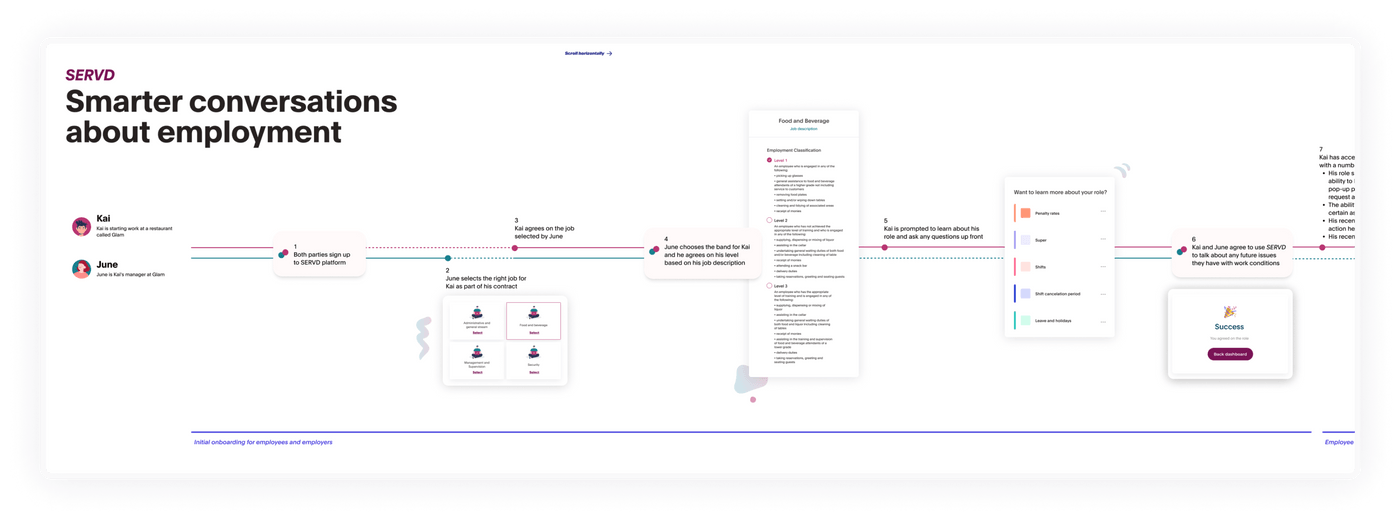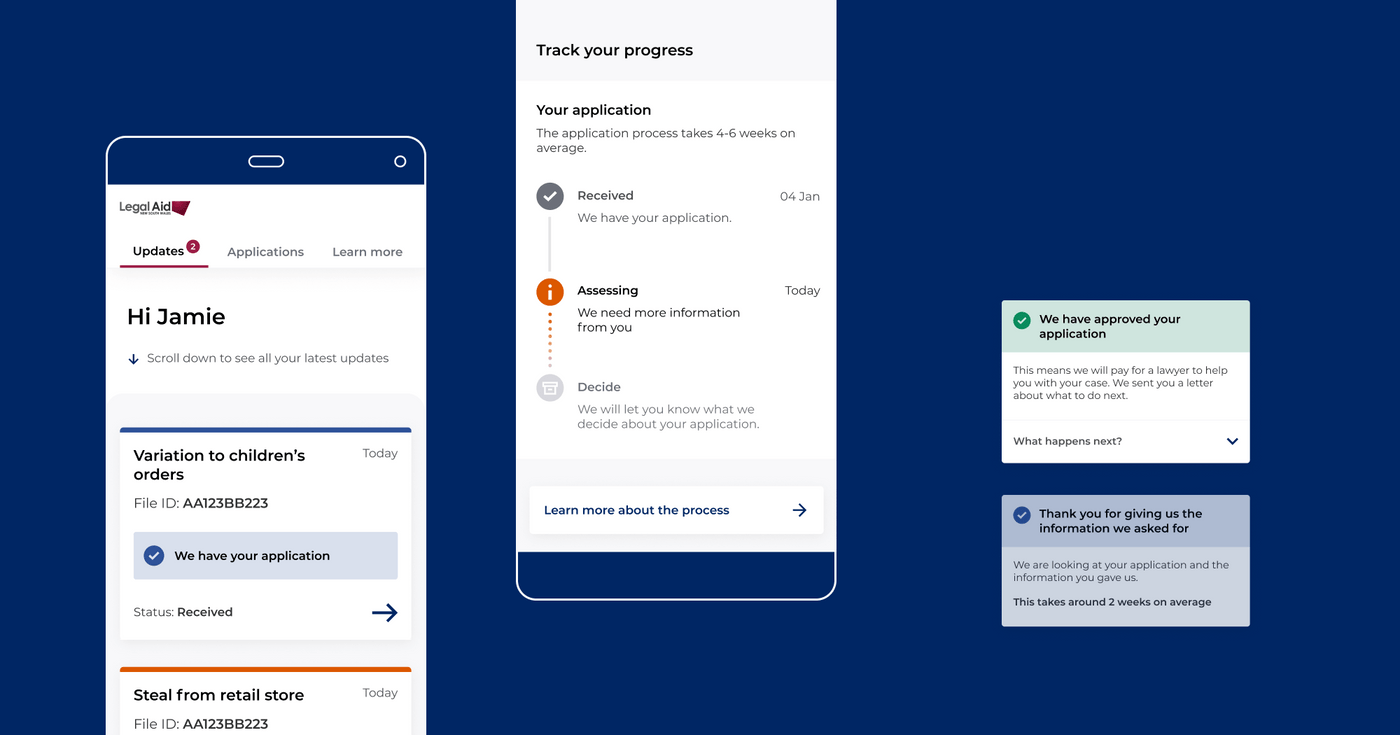Making change in any large and complex sector, like the justice sector, is hard. It takes time – always more time than you initially think – especially if you want the thing you are changing to make a long-lasting impact. Years ago we decided we didn’t want to just build another new website, app or experience for it to be forgotten about by the next news cycle. This decision made us shift how we redefined innovation from the project to the process. We worked to define a range of impact areas, the first one being Justice. We had a goal to make Australian legal processes more accessible and intuitive. It also transcended our thinking around the newness of technology and design and instead made us focus on creating lasting change. We have used this innovation vision to expand into other impact areas including health, education, mental health and more. Our vision is to not only meet, but exceed people's expectations of services.
As design thinking and digital technology have become omnipresent in our world and culture, the opportunity to use these tools to create impact that will improve the lives of citizens has become even more exciting. Yet with lots of exciting things, it’s easy to get distracted and move onto the next Web 3.0, or cryptocurrency, NFT, or whatever the current trend is. Trends are important, they create opportunity in areas where there wasn’t one before, but it is essential to have a North Star – an ultimate goal or aim – to remind yourself why you’re doing this in the first place.
When Andrew and I started working together, the trends on the internet were based around Web 2.0 and early social networks. We used this to help set up the Portable Film Festival. Without this, Portable would not be here. We needed this spark of inspiration. More importantly, we needed to find the fuel to keep us going. Sixteen years in, we've been working to distil this into a process we use across our 70+ staff, across every State and Territory and with our networks to make change.
A common criticism of design thinking is that designers just follow an abstract thinking process – they don’t implement anything tangible. I often hear designers at conferences say things like, “It was a great solution, but the client didn’t take it up”. In my opinion, that’s a cop-out answer. That’s phoning it in.
The hard bit is the doing bit, the implementation bit. But it’s also the fun bit and the purposeful bit. Design should be a verb, not a noun - it should be about design doing, not just design thinking. So, we wanted to share some of our tips over the past 16 years that we’ve used to help bring ideas and concepts to life. At Portable, this was initially film, then fashion and now in the for-purpose space.
These learnings are reflections from Portable’s work in improving access to justice, but i feel that they could be just as easily applied to making change in any public facing and complex sector. We use these to make change across our impact areas and hope you can find inspiration in it too.
Expand your universe
Using the metaphor of time and space is intentional. You will need more of both to envision a solution that will build support, be engaging for other organisations, and outlast your involvement.
The challenge is not to make it too big that your universe will implode on itself and create a black hole, nor too small to not create a planet. We’d recommend talking to others to both get them excited and also help shape the universe you are wanting to work in, so that it can be possible. Our standard way of thinking is how do we use design and technology to make change? The fun bit of this thinking is exploring what the change piece we are wanting this to be. So give it a try, who can you get interested?
Build the coalition of the willing
It can be lonely doing something on your own. It can consume you. When you’re expanding your world think of the organisations, lived experience experts and community groups you want to share it with. What role do they want to play, are you solving a shared problem? How does doing your work help these other people?
Thankfully the tools of design and technology provide a really large canvas to work with. We’ve found in a lot of our impact areas that people are screaming out for enthusiastic and motivated people to help solve issues they themselves have been wanting to work on for years. We’ve found hundreds of people who are innovators and designers in and outside organisations, who have never labelled themselves as such, but through the design process have been empowered to make change.
Get momentum first
Don’t use a lack of funds as a reason not to pursue something. People like good ideas, they love good ideas with momentum. Work to develop what you can first and foremost with the resources at your disposal – your own time, the existing resources in your existing role, those other partners in your coalition.
Use the tools you can get access to and design a prototype of what you’re looking to do. This could be a short business plan, it could be a series of interactions you are wanting to do or an insights report. Start to build these next few steps and then use the space to see where others can help you.
Don’t be afraid of getting into Research & Development (R&D). You don’t need to be a scientist in a lab. You just need to be able to document and show what you’re looking to do, have a clear hypothesis, test and iterate. As Voltaire said “Perfect is the enemy of the good”, get into the mindset to keep on making, iterating and showing incremental change for your broader goal.

Find the right place to experiment
From our experience, we’ve always found the best traction is to experiment a little out of the spotlight. As you are building momentum, start with small experiments. Test that the idea you’re looking to do is actually going to solve a problem that people have.
Conduct some interviews, design a prototype to share with a small network of people, or work with an agency seeking to solve something similar. Where we’ve seen things fail is people thinking they will nail it or knock it out of the park at the first attempt, they create a very public space to work and then 98% of times it doesn’t meet the high expectations that have been set for it. So the problem is still not solved and the cycle continues. The organisation gets conservative and pulls it, the teams gets deflated and people take their bats and walk away. The sad thing is in most of these cases worthwhile change had been made but not enough to justify an ongoing commitment. Don’t lose faith, just find the goldilocks space to experiment.
Be declarative on IP at the outset
Most of our work is with the government. We believe in a world where government services can be delivered in a way that exceeds citizen expectations. If you solve problems in one territory or service it is likely that there will be a need for a similar service elsewhere.
Governments are not incentivised to fix problems outside of their jurisdiction. You should be, so work to bring up IP at the outset. Getting access to the IP, whether outright or sharing, provides a space to be declarative of your intentions and paint the bigger picture of what you’re seeking to engage others in that journey. You’ll be surprised by how doing this will also help you find others wanting to make the same change you do.
You having IP is not the default position of government and their legal teams will push back. Some of this is changing in more innovative areas but it is still a new concept. It’s worth spending the time to get it right, as it gives you the incentive to keep at it well into the future once all the current team has moved on, and moves something from one project to an ongoing opportunity. We have built a long-lasting relationship with Legal Services Commission of South Australia, with shared IP between us for the amica online dispute resolution tool. This relationship means that we are both invested in making amica a great, long-lasting and evolving digital product so it won’t just get forgotten if there is a policy change or change in guard. We have used this model in how we help people get updates on their legal aid grant application, navigate a court room, improve the before and after court experience and prepare for the end of life process.

Play the role of the third party
We’ve found that where innovative change works best is when you play the role of the third party. Bringing together an organisation with no access to money (typically due to internal politics and positioning in their sector) yourself and then another agency who are committed to solving a similar problem who do have access to money, but don’t know where to deploy it.
This is where you can come in and become the enabling agent for cross-organisation collaboration. Many of the problems you’re seeking to solve will be shared across a range of different organisations. Within the government context there is little incentivisation or processes for this coordinated approach, but through having a clear problem you’re seeking to solve, you can work to bring people together to support the funding of the initiative. Working across government, you can also share with each agency ways of working from IP to service agreements.
Create new streams of revenue
Many of the services that are delivered in government are delivered for free and for those who are most in need. As the issues that people face become more complex the ability to continue to provide this level of support will become harder.
We believe it is critical to be able to continue to offer services for those most in need. But for those that can self-service, consider creating a model of where you get people to make a contribution towards the service as a way of self-supporting the model.
Like a public-private partnership but for services. We have done this for amica, the tool to help couples separate without the need for a lawyer. The concept came from us and National Legal Aid, the peak body for legal aid organisations throughout Australia. There is a free version for those that need it, and a paid one for people that can afford it. The rationale we have is that amica is still considerably cheaper than engaging lawyers for two people seeking an amicable divorce. We saw this as an avenue to support establishing services that, in time, could work towards supporting themselves. It also is more palatable for government agencies to fund if there is a long term fee or cost-based recovery model in place. What are all the other services out there that design and technology can be used to provide a more cost-effective pricing model for users? That’s a space definitely worth disrupting!
Got an idea for an impactful project, but need help building the momentum? We’d love to chat and help you in the journey.
Reach out to Simon at simon@portable.com.au